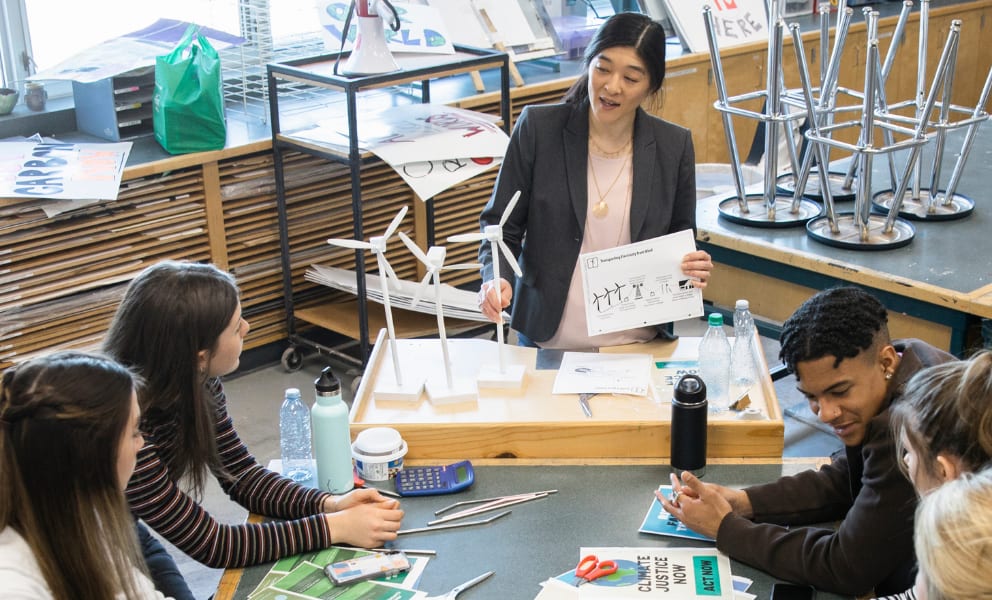
Q. What benefits do you think that the BTU Crew provides for students?
A. The biggest benefit the BTU Crew offers is that it opens students’ eyes to possible jobs/careers that they never knew existed, especially in the renewable energy field. They also learn how energy how can directly impact their lives in the future, what their energy bills are going to look like, for example.
Students also learn how we can save our school money. They do enjoy that part of it and they say, “wow, we spend a lot of money on energy, how we can save money and use that for other things we want in our school, like updating our locker room or things like that.”
Q. What surprised you about how students responded to the program?
A. I couldn't believe the level of motivation that I got out of them. Honestly, I have over 100 kids and when we are talking about energy, I would say at least 90 to 95 percent of the kids are engaged in that project. It’s fun to see They're truly having fun in class, and they can't wait for the next one. So, my job is fun. I love being a STEM teacher for sure.
Q. How do the students respond to data that shows how their school building uses energy?
A. Looking at the data from the energy sensors in our building is a huge gain for these kids. Most schools don’t have this and it’s really exciting for them to see how much energy we use on a given day.
It’s eye-opening for the students to see the data. We have a lot of conversations about it. Some days, it seems like we could talk the whole class period if we really dug into it.
They like to look at our school calendar and if we have a spike on a day, they like to see if we had any events. They've learned that the use of our gym actually requires a lot of electricity, which costs a lot of money. We’ve had conversations about, “What do we charge for our gym usage? Is it enough? Is it not enough?” which is fun to see.
One of my favorite moments is that they realized on New Year's Eve there was a spike and they commented that, “the teachers had a big party!” But it was a youth basketball tournament, so they got to go back to our calendar and see that.
Additionally, using graphs is such a huge gain for them now and going forward, even for taking their ACT testing. The more we expose them to these things, the better off they are. It’s fun for them since it's not just a graph out of a math book. It's actually a graph of our school. So, the motivation level is a lot higher.
Q. What impact does the opportunity for students to learn about energy use in their own school building have on them?
A. Learning about energy in their own school has a great impact on students. We talk about how we use electricity and about non-renewable and renewable energy and ask questions such as:
- Why is it important that we have both?
- What concerns are we having with nonrenewable?
- If we don't make the right choices, what do our futures look like and what do their kids’ futures look like?
We’ve discussed what we can we do to conserve energy so that we all have it for a long, long time. I think when they make that real-life connection it impacts them. I don’t think they realized where their energy comes from before this. So, learning about this is great for the whole rest of their lives.
Q. What changes have students been able to make to their school environments based on implementing the BTU crew?
A. Certain students, those who are super passionate about energy use, have already talked with our school board, our building administrators and even our city administrators about changes.
While they already knew it from using the classrooms, they could see by looking at the data, that certain rooms in our building are really hot and others are really cold. Some rooms also showed concerning CO2 levels. The administrators worked with Trane and they came in and fixed these issues for us.
The students also came up with ideas to save energy. For example, we installed sensors in our restrooms so that the lights are not on all day. They also track a small solar farm that was added.
We also noticed from the data when our heating and cooling systems are turning on and shutting down. They weren't working the way they should. We had some turning on at 4 am when we are not even in the building till 7 am. So, those were all fixed to help save energy which also definitely saved money. It'll be fun to see the long-term money savings from these changes as the years go by.
Now, the students look at the data and when they see an issue, they talk to the administration and the administration talks to Trane. The students know that when we find anything that needs attention, we let our administration know.
Q. How do you think this power to affect change impacts the students?
A. I think that this power to affect change helps students know that they have a voice and they can actually impact the school and save money. I do see internal motivation when it's directly connected to them. I see that they're way more invested in their learning when they know they can save money to buy other things they want in the future for our school.
They do really like looking at the live data and we do have awesome conversations about it. Sometimes our conversations even have to go into the next day, because the bell rings and they want to keep talking about it.
Q. What do you think about the fact that the BTU Crew program includes Trane Educators-In-Residence – former teachers who provide training and implementation support?
A. Having the Educators-in-Residence really sets the program apart. It is a huge plus, a huge perk. It was a big piece of making the program successful and making it successful fast.
When we first started with the BTU Crew in our school, I learned that we were going to put sensors in our school and track the data as a part of our educational efforts, I was a little overwhelmed initially. I didn't know where to go with it until we met Dan Whisler, our Educator-in-Residence. But once we sat down with Dan and we mapped out our long-term plans, I felt so much more comfortable.
I would not be doing what I'm doing if it weren't for Dan Whisler. He definitely walked us step-by-step through the program and showed us all the resources we needed. We still have conversations with him all the time and I know he really roots for all students. He is a great example of a good educator, and he also helps us in anything that we need. The kids keep calling him “Dan the man” for a reason.
Q. How do you think the BTU Crew will impact students’ attitudes about STEM learning in the future?
A. I think how the BTU crew impact students’ attitudes about STEM is already showing for us in our school because we've now implemented it for multiple years in a row. We are already starting to see some students graduate and pursue related careers. It’s really fun for us to see that it may have impacted the rest of their lives and see that they are going out and getting related jobs.
Q. Why do you think STEM education is important for students today?
A. There are so many jobs/careers in STEM now, and I feel like those opportunities are only going to keep growing. I think it's vital that they learn what is out there so that they can make an educated decision about their futures and what they want to do. Students need to be exposed to STEM careers and all the opportunities out there so they can pursue them.
Another positive of STEM education is the problem-solving and collaborative skills the kids learn through group work. It's fun to see a lot of the students that you wouldn't necessarily think would enjoy it really take off with STEM learning!
Trane is a strategic business of Trane Technologies, a global climate innovator. Through its Sustainable Futures program, Trane Technologies brings bold action globally to uplift under-represented students through education and pathways to green and STEM careers. The futures of both our industry and our planet demand bold, diverse thinking and we're determined to inspire a new generation.
K-12 Education

About the author
Christie Fouts, Junior High Technology Teacher, Beloit Unified School District 273, Beloit, Kansas
Christie Fouts teaches seventh- and eighth-grade STEM/Technology classes at Beloit Junior/Senior High School where she has worked for five years. She brings 13 years of teaching experience to what she calls her dream job as science, technology, and mathematics are her passion and that’s what she teaches every day through STEM. “I love what I do and feel that STEM education is very important to expose students to because the job opportunities in the STEM field are abundant and only keep growing!”
Christie has a bachelor’s degree from Kansas State University and a Master’s degree in Instructional Technology from Fort Hays State University. She and her husband and three children live in her husband’s hometown of Beloit











































































